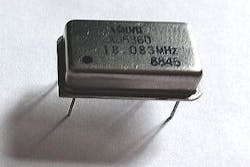Air Force chooses crystal oscillators from Syntonic Microwave for B-1B bomber EW system
Officials of the Air Force Materiel Command at Robins Air Force Base, Ga., announced plans last week to order a variety of crystal oscillators as spare parts for the ALQ-161A. The value of the upcoming contract has yet to be negotiated.
The AN/ALQ-161A is designed to detect and counter radar-based weapon systems and also provides a tail warning function to detect and counter incoming missiles coming in from behind the B-1 bomber.
A crystal oscillator is an electronic oscillator circuit that uses the mechanical resonance of a vibrating crystal of piezoelectric material to create an electrical signal with a very precise frequency to stabilize frequencies for radio transmitters and receivers.
Syntonic Microwave specializes in custom and customizable microwave components and subsystems with proprietary digital synthesis technology and traditional microwave skills. The company has a reputation for meeting difficult design challenges.
The AN/ALQ-161A defensive EW system provides 360-degree simultaneous receive and jamming coverage against a large number of radar-guided missiles and other threats to the Lancer bomber. The electronic countermeasures system sorts threats by priority and responds to them automatically while allowing for man-in-the-loop intervention, Exelis officials say.
The AN/ALQ-161A has more than 108 line-replaceable units (LRUs), weighs more than 5,000 pounds, and uses about 120 kilowatts of electricity. The system was designed in the 1980s by AIL Systems Inc., and now belongs to Exelis Electronic Systems in Clifton, N.J.
The AN/ALQ-161A has been sustained through a series of operational flight program block cycle upgrades and hardware upgrades for modifications to keep up with evolving electronic warfare needs.
The B-1B supersonic bomber is expected to remain in the Air Force inventory through mid-century, and Exelis officials say they are developing new capability for the AN/ALQ-161A to meet future needs.
For more information contact Syntonic Microwave online at www.syntonicmicrowave.com, or the Air Force Materiel Command at Robins Air Force Base at www.robins.af.mil.

